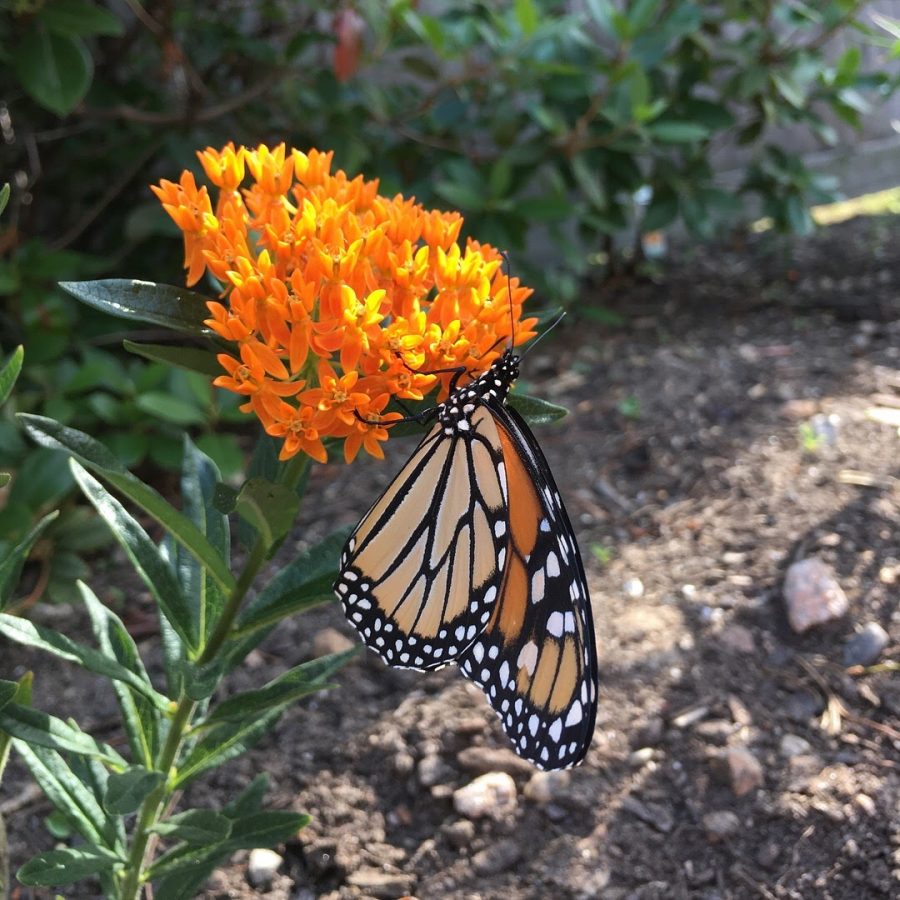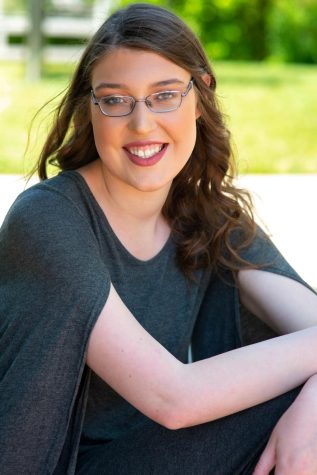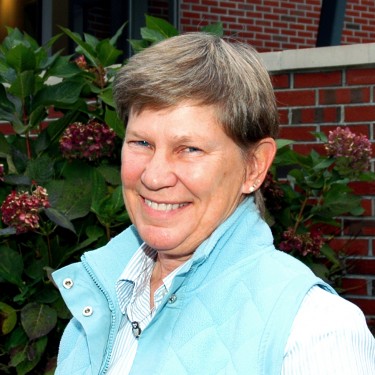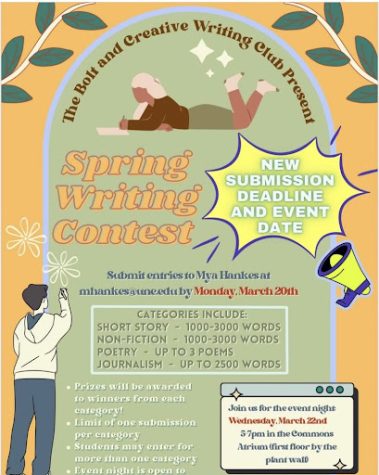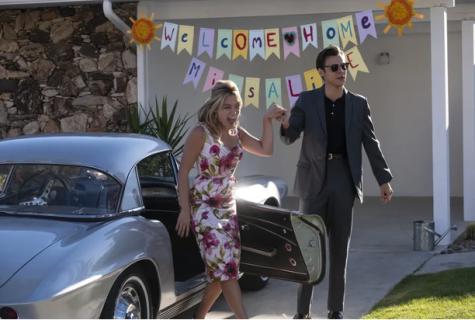Monarchs and Milkweed Gardens
A monarch butterfly feeding on the nectar of butterfly weed, Asclepias tuberosa, in the garden next to Siena Hall. Photo courtesy of Olivia Scott, Class of 2020.
With Earth Day celebrated a few days ago, I thought it would be a great time to showcase one of the many projects students on UNE’s campus have contributed to helping the Earth and her creatures. I had the privilege to interview Olivia Scott ‘20 about her achievements on planting and maintaining milkweed within two areas on UNE’s campus. As a fellow student in Dr. Klak’s ENV 309 class, I have recently learned about Monarch Butterflies and the one plant they need to survive in the larva stage, the Milkweed. Milkweed does not have the most beautiful appearance but its ecological role in the life cycle of the monarch butterfly is irreplaceable.
As Olivia states, “Milkweed is the sole host plant of these butterflies, meaning that this is the only plant that the larvae (caterpillars) can consume.” It was not an easy process to establish these spots to grow milkweed, but Olivia has been able to work with UNE’s Maintenance and Facilities to reach an agreement. Currently, there is not an established group to maintain the milkweed gardens and Olivia graduates this semester. In the interview below, Olivia gives us some more information on monarchs and milkweed gardens.
What inspired this idea of a milkweed garden on campus?
Toward the end of the summer of 2017, my mom and I noticed monarch eggs on some milkweed that was in our backyard. We watched the caterpillars get bigger by the day, but one by one the small caterpillars were disappearing (likely eaten by other insects or birds). We took the last one in and let it grow in the safety of our home, releasing it when it was a butterfly. It was amazing to watch this transformation. The following year (spring semester of 2018) I took the class ENV 309, Sustainability and Ecological Restoration, taught by Dr. Tom Klak. Part of the curriculum covered monarch conservation and I became even more interested in what I could do to help this declining species. Dr. Klak told us about his involvement with monarch butterflies; each summer he raises and releases several hundred butterflies, tagging the last cohort with special stickers. This tagging activity is part of a larger citizen-science effort to understand the monarch butterfly migration. The stickers each have a unique serial number that you register in an online database that can later be looked up when the butterfly is found in Mexico. Dr. Klak also taught us about the native wildflower garden (called the Native Prairie Garden) that he created on campus, and a few other classmates and I became interested in making another garden with ample milkweed to support monarch butterflies. We decided to go for it and ended up planting milkweed and other native plants in the small garden next to Siena Hall. In addition to this, that summer I started a petition to ask the Facilities Department and the groundskeeping crew to stop removing common milkweed in select locations (the garden next to Stella Maris and the garden by the Pett’s Health Center). Dr. Klak had told us that these locations have the highest amount of monarch activity on campus, and he was right. The common milkweed is highly prolific in these areas; every summer the gardens are teeming with monarch butterflies and caterpillars.
What was the process to begin the project on campus?
In order to get approval for keeping milkweed in the garden next to Stella Maris and by the garden next to the Pett’s Health Center, I collected signatures and wrote a letter to the Facilities Department, as well as President Herbert. Then, Dr. Klak and I had several meetings with Sustainability Coordinator Alethea Cariddi to come to an agreement on the terms of the gardens. At those two gardens, the common milkweed grows naturally each spring, so we simply let it grow. In addition, we created an informative sign that is placed in front of the garden next to Stella Maris, explaining the project and why milkweed and nectar plants are so important.
What is the purpose behind the garden?
The purpose of these gardens is to provide more habitat for monarch butterflies and raise awareness. Milkweed is the sole host plant of these butterflies, meaning that this is the only plant that the larvae (caterpillars) can consume. Without an adequate supply of milkweed, monarch butterflies will cease to exist. Monarch butterflies are the second-farthest migrating insect; the butterflies that emerge from their chrysalises in New England and southern Canada in the late summer/early fall migrate all the way to central Mexico. There are several reasons why this species is in decline in North America, including a lack of milkweed, agricultural use of pesticides and herbicides, extreme weather events caused by climate change, and logging of the oyamel fir forests in Mexico. Every person can do their part to help monarchs by planting milkweed in their gardens or allowing it to grow where it naturally occurs.
Where is the garden located?
There is a small collection of milkweed and other native plants in the raised garden next to Siena Hall. The larger garden with the informative sign is located next to Stella Maris, to the right of the sundial. The third garden is next to Pett’s Health Center. Additionally, the Native Prairie Garden is located between parking lots near the SASC and is also contains a lot of Milkweed which the monarchs love.
Is there a club associated with the garden? How is the garden maintained?
Originally, there was going to be a club associated with the garden, specifically pertaining to monarch butterflies, but everything was happening as the academic year was ending and many of the interested students graduated. The gardens have been maintained by myself, Dr. Klak, Emily Payne (’19), students from Dr. Klak’s ENV 309 class, and Dr. Bethany Woodworth’s ENV 104 class. Because I am graduating, I have been reaching out to several students to see if certain clubs would like to continue the project. Members of the Earth’s Eco and the Honeybees Conservation Club expressed a great deal of interest and will be maintaining the gardens from this point forward [but no students are on campus for the foreseeable months!]
What would be the best time to visit the garden? What kind of wildlife can be seen in the garden?
Great question, the best time to visit the garden would be in the summer to early fall. This is when the adult butterflies are breeding. You can often see them drinking nectar from the flowers or even laying their eggs on the milkweed. You are guaranteed to find many caterpillars feasting on the leaves. There are also other types of butterflies and insects enjoying the nectar of the milkweed and other flowers in the gardens.
What are your future hopes and plans for the garden?
In the future, I hope that the garden will be maintained by Earth’s Eco and the Honeybees Conservation Club. I would love for the gardens to be expanded or for there to be community outreach to educate the public on monarch conservation.
Anything else you would want the UNE community to know about the garden/project?
“You don’t need to be part of any club to help. As you pass any of these gardens, please not only enjoy the native plants and insects but also take a moment to pull a weed or two. Nature will thank you!” – Olivia Scott
“People can make a difference for butterflies and wildlife right in their backyard, just plant native plants” -Dr. Tom Klak



